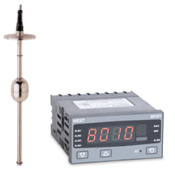An indicator, sometimes called a digital meter or display, is an electronic device used to read an input value from a measuring device and show a displayed value. What appears on the display will represent the units of measurement sensed by the measuring device.

The controlled variable is measured by a suitable sensor and converted to a signal acceptable to the indicator. The indicator receives that signal and converts it to a value representing the appropriate unit of measure. Alarms, signal retransmission, and communication can be programmed into the indicator.
Example:

Gems XT-800 Series continuous float level sensor measures liquid level in a 150 gallon tank and sends a 0-10 VDC scaling linear signal to a West 8010 Plus Series Indicator. The indicator converts that signal to read anywhere from 0 to 150 gallons on the display. The indicator is programmed to provide two output relays for alarm indication when the float sensor drops down to 20 gallons and when it rises to 130 gallons. These alarms notify the operator that the tank volume is too low or too high. The indicator has also been programmed to send a different linear output signal of 4-20 mA scaled to match the 0-150 gallons being displayed. This is called retransmission.
An indicator is often used in an application where control of the process is not needed. It can also be used to display a value for a process that is controlled elsewhere.
Indicators can have many auxiliary functions:
- Latching Alarms
- Logic and/or Alarms
- Active Alarm Elapsed Time
- Tare function
- Min/Max Process Value Retention
- Custom Multi-point Scaling
- Retransmit
- Communications
- Integral Power Supply
- Digital Inputs
Gems Sensors & Controls and West Control Solutions are happy to offer a wide range of indicators to help with your process display needs. See more HERE.
 SEARCH OUR RESOURCE CENTER
SEARCH OUR RESOURCE CENTER

